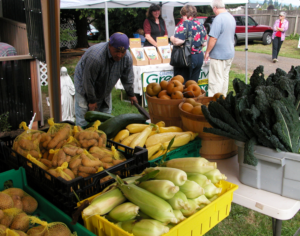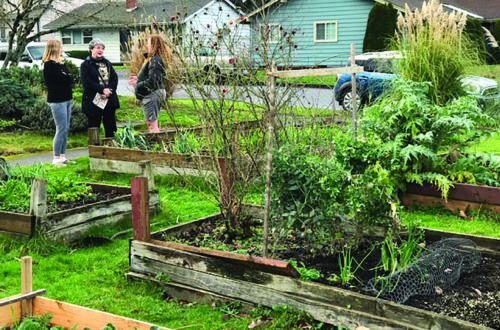Shopping in large corporate grocery stores that are open 24/7 is convenient. Supporting a local agricultural economy requires more planning, commitment and thought. Here are ten powerful reasons to do so:
 1. Contribute to the Local Economy
1. Contribute to the Local Economy
Buying food from chain grocery stores depends on a large infrastructure to support a global food system that removes about 93% of food dollars from a local economy. When you buy directly from a local grower, 90% of that money is returned to the grower and stays within your local economy.
2. Empower Regional Food Access and Security
Most people know the adage “don’t put all your eggs in one basket” as a warning against risking losing everything in one event. But our centralized food structure does just that by relying exclusively on the transportation system to deliver our food from distant places. For decades cheap oil has fostered the unusual arrangement of transporting food thousands of miles from its origin. Purchasing food from farmers and ranchers in your region builds an agricultural network that will be affordable and reliable when oil no longer is.
3. Develop Community
Robert Putnam noted in his book, Better Together, that since the late 1960s, Americans began “to join less, trust less, give less, vote less and schmooze less.” Gathering our weekly food does not have to be a chore on list; it can be an experience, even a celebration! Buying directly from growers at a farmer’s market or through a Community Supported Agriculture (CSA) offers a weekly opportunity to meet your neighbors and know your farmers.
4. Reduce Environmental Impact
Our current centralized agricultural system uses a significant amount of energy to grow, package and deliver food. Large factory farms generally use petroleum based fertilizers and pesticides to produce crops (leading to soil depletion and erosion). Those crops are then encased in foam and plastic so they can travel in a refrigerated compartment 1500 miles (average mileage for food product transportation). After delivery, refrigeration is often required so the crop remains presentable to consumers. This system is responsible for at least 20% of the United States greenhouse gas emissions.
In addition, the plastic packaging used in this system has substantially impacted our waste stream. In 2009, US consumers used 13 million tons of plastic containers and packaging. Only 9% of that plastic was recycled.
Locally produced food uses far less energy in all aspects of growing, packaging and transporting. Bringing a bag or basket to the market eliminates much of the plastic used in our food system.
5. Witness Passion and Commitment
People who grow food for a living are well aware that farming is not a “get rich scheme.” Long hours that require physical stamina, risk factors beyond their control (weather, pests, etc.) and a lack of financial security can easily wear down the toughest farmers. Many factors can motivate a person to grow food but it’s likely that passion for both the process and the product plays a big role in their commitment to farming.
6. Enhanced Quality and Nutrients
Shipping produce from other parts of the country and the world requires growers to pick it 4 -7 days before it is ripe. Despite careful packaging and refrigeration, most produce will lose a significant amount of its nutritional value during its travels. Local growers often pick the day before the market or CSA delivery to ensure ripeness, freshness and nutritional quality.
Locally raised meat generally lacks the additional antibiotics used with factory-farmed meat. Studies show that grass-fed beef, often available only from local sources, has a higher amount of omega-3s, a beneficial fat that aids in brain function.
7. Explore the Diversity of Food
Step into a produce department of a grocery store and you will usually find two kinds of lettuce, one type of carrot, two kinds of onions, and two or three kinds of potato – selections that are designed to travel many miles and still look good in the market weeks after the crops were picked. Stroll through a farmer’s market and there is no way to predict what you will find! Local growers select crops for a variety of reasons: adaption to geographical regions, exceptional taste, heirloom qualities, rarity, and for some, unusual physical traits can persuade a grower to give it a try. How many varieties at a farmer’s market? One never knows…
8. Celebrate the Seasonal Abundance
With the exception of the last 50 years, humans have had a seasonal relationship with food. Food was grown, preserved when abundant, and treasured during the winter. The international infrastructure of modern agriculture has altered our expectations for food availability; fresh produce in the winter is a modern invention that most of us enjoy. Buying locally produced food is a wonderful way to celebrate the seasons of food.
9. Rediscover Taste
Most local growers are not concerned with transporting their products for thousands of miles. Instead they can select varieties that are known for one primary quality: flavor. Thanks to processed foods, laden with fat, salt and sugar, our taste buds have been numbed a bit. Warning: A visit to the farmer’s market or a CSA delivery can introduce flavors that will alter future expectations for flavor. Taste at your own risk!
10. Voice your Values
Kentucky farmer and acclaimed writer Wendell Barry wrote, “Eating is an agricultural act.” Choosing to buy a portion or all of your food at a local farmer’s market, through a CSA or from a meat producer is an opportunity to vote for a food system that supports regional growers and ranchers, nurtures a local economy, is kinder to the environment, assures high nutritional quality, and delights in diversity and exceptional taste.
Sue Kusch is the owner of Plants n People




